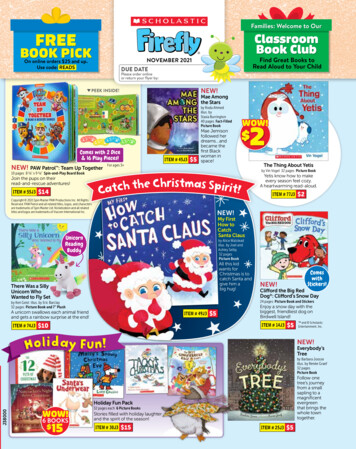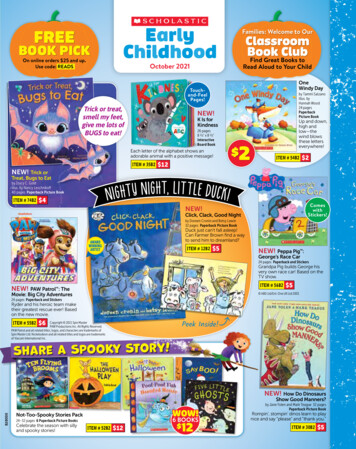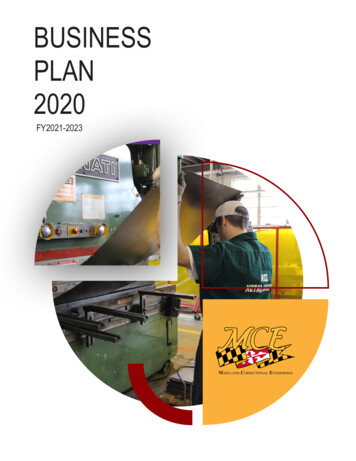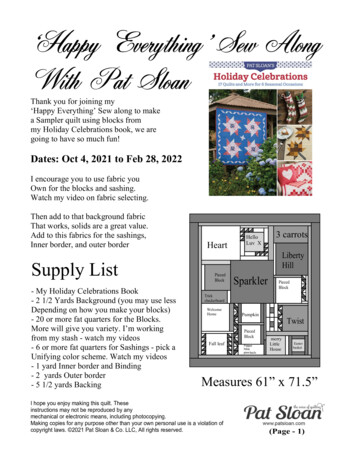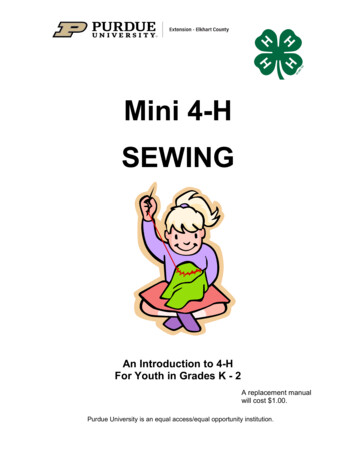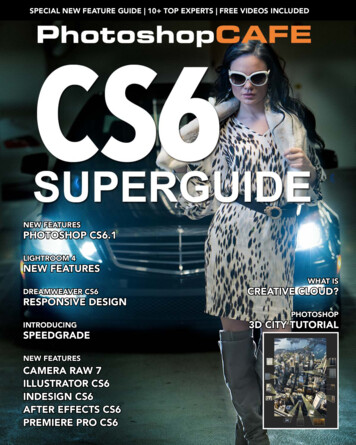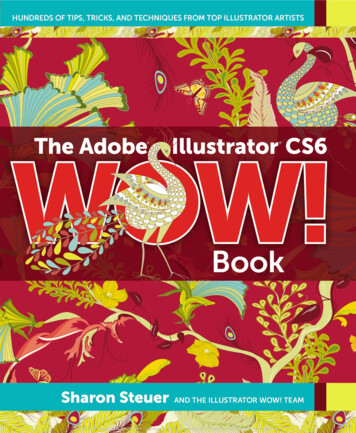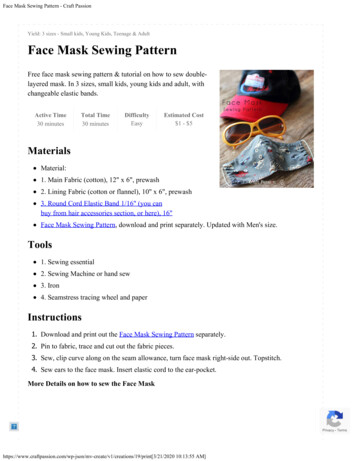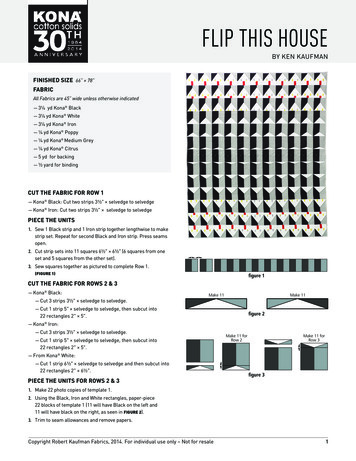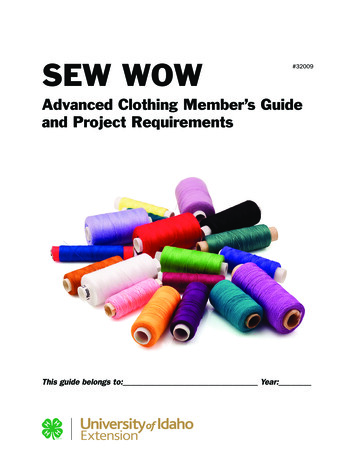
Transcription
SEW WOW#32009Advanced Clothing Member’s Guideand Project RequirementsThis guide belongs to: Year:
SEW WOWAdvanced ClothingMember’s Guide and Project RequirementsContentsProject ObjectivesProject Objectives .2 Learn to enjoy and appreciate the process ofclothing construction.Requirements .2 Acquire the advanced skills needed to createa garment, outfit, and/or accessories.Focus Areas Summary .3General Resources .3 Develop confidence through successfullycompleting the project.Focus Area A: Active/Sportswear .4Focus Area B: Outdoor Wear .6 Share what you have learned with others.Focus Area C: Western Wear .8RequirementsFocus Area D: Formal Wear .101. Select one project focus area that includesthe clothing item(s), fabric, and constructionskills you want to master. A summary offocus areas is on page 3.Focus Area E: Embellished Apparel.12Focus Area F: Tailored Apparel.14Focus Area G: Pattern Your Own .162. Set at least three goals to achieve in thisproject year.General Advanced Activities .18Project Summary .193. Do one of the “General Advanced Activities”and complete part A of the project summarypage in the back of this guide.Part A: General Advanced Activity .19Part B: In-Depth Study Topics .20Garment Cost and Care Record.214. Learn about at least two “In-depth StudyTopics” for your selected focus area.Complete part B of the project summarypage in the back of this guide.Project Self-Evaluation.225. Complete the specific requirements listed forthat focus area.6. Exhibit the garment(s), outfit, and/or accessory constructed using the skills learned inthe selected focus area.7. Optional: model your constructedgarment/outfit in the Style Revue in yourcounty.2
Focus Areas SummarySelect one focus area as your advanced 4-H project.Focus Area A: Active/SportswearFocus Area D: Formal WearExamples: workout set, swimsuit, sportuniform, sweatshirt, sweatpants, danceuniform, running wear, or other active orsportswear itemExamples: prom dress, wedding gown,bridesmaid dress, evening suit, black tieoutfit, rodeo queen outfitFocus Area B: Outdoor WearExamples: vest, jacket, pants, dress, blouse, t-shirtExamples: windbreaker, rain-gear, jacket,coat, snowmobile suit, skiwear, slicker, vest,pants, and/or other insulated clothingFocus Area F: Tailored ApparelFocus Area E: Embellished ApparelExamples: suit, jacket, blazer, vest, pants,coat, topcoat, skirt, dressFocus Area C: Western WearFocus Area G: Pattern Your OwnExamples: jeans, prairie skirt, denim skirt,riding jacket, gaucho and vest, western shirt,chaps, rodeo outfitExamples: vest, jacket, pants, skirt, jumper,dress, blouse, garment from an earlier clothing era like medieval, 1920sGeneral ResourcesThere are many books, magazines, andsewing guides available in libraries, fabric andcraft stores, and on the Internet. Web sites tocheck out for additional resources and supplies: Sewing organization sites like Home SewingAssociation, Sewing & Craft Alliance (SCA),Sew USA Sewing magazine sites like Sew News,Threads, Sew Beautiful Pattern company sites like Simplicity,McCall’s, Butterick, Folkwear Sewing notion and supply company sites likeClotilde, Nancy’s Notions, Coats and Clark,Prym Consumer USA, Gingher (scissors),Berwick Offray (ribbon), Sulky (thread),Wrights (embellishments) Sewing machine company sites like Brother,Singer, Bernina, Husqvarna Viking, Pfaff Fabric company sites like Hancock Fabrics, JoAnn Fabrics, Fabric.com, Fabriclink, FabricDirect.com Related sites like Soap & Detergent Association - laundry section3
Focus Area A Active/SportswearExamples: workout set, swimsuit, sport uniform, sweatshirt, sweatpants, danceuniform, running wear, or other active or sportswear itemA. Study and learn more about TWO of the following IN-DEPTH STUDY TOPICS.Complete part B of the project summary page in the back of this guide.J Good fit principles of active/sportswearJ Fiber content and characteristics of single and double knit fabricsJ How to determine the right and wrong side of knit fabricsJ Knit fabric finishesJ Suitable uses for fabric blendsJ Care requirements for knit fabricsJ Special construction techniques required for knit fabricsB. Construct a garment or outfit using ONE or more of the following fabrics:J Single or double knitJ Swimsuit fabricJ Stretch knitJ Polar fleeceJ OtherC. And with at least TWO of the following advanced construction skills:J Welt, flat fell, or other type of closed seamJ HoodsJ ZipperJ French or mock French seamJ RibbingJ Elastic application in leg/arm openingsJ Matching plaidsJ PleatsJ LiningsJ Other4
D. Exhibit two small or one large active/sports clothing item(s). Accessories (hat, bag,gloves, belt, etc.) can be made to match garment or outfit to help fulfill needed construction skills.E. Give an oral presentation (demonstration, speech, or illustrated talk) related to thisproject.F. Complete the 4-H Project Record Book (#91950) and the 4-H Involvement Report(#91910).Focus Area A Planning GuideRecord what you plan to make, the fabric you will use, and the focus area A skills youwill learn.Focus Skills IPlan to LearnThis YearExample:sweat jacketType and fibercontent of fabric(s)double knit 100%polyRequiredconstruction skillhood, attachedRequiredconstruction skillseparating zipperOtherconstruction skillribbing hemClothing Item1:Clothing Item2:Otherconstruction skillResources:Specialty Sportswear: www.specialtysportswear.com—patterns for ice skaters, gymnasts,dancers, swimmersStretch and Sew: www.stretch-and-sew.com—stretch and sew patterns and information5
Focus Area B Outdoor WearExamples: windbreaker, rain gear, jacket, coat, snowmobile suit, skiwear, slicker,vest, pants, and/or other insulated clothingA. Study and learn more about TWO of the following IN-DEPTH STUDY TOPICS.Complete part B of the project summary page in the back of this guide.J Three types of outdoor apparel fabrics and their characteristicsJ Characteristics of fabrics that make them desirable for outdoor useJ Three types of insulators and their characteristicsJ How to decide when to buy or to sew outdoor wearJ Finishes applied and their suitability for outdoor fabricJ Care requirements for outdoor fabricB. Construct a garment or outfit using ONE or more of the following fabrics:J Outdoor nylons like ripstop, oxford, or taffetaJ Medium to heavyweight woolJ Suede, leather, or vinylJ Spandex blended fabricJ Nylon/rubber bonded fabricJ Fur, fake fur, or other outdoor pile or napped fabricJ Quilted outdoor fabricJ Insulators like down, polyester batting, interliningJ Polar fleeceJ OtherC. And with at least TWO of the following advanced construction skills:J Welt, flat fell, or other type of closed seamJ Hook and loop type closuresJ Seared edge finish on nylon fabricJ Buttons, eyelets, and/or snapsJ Princess-line seamsJ Separating, exposed, or two-way zipperJ Machine quiltingJ Zipper with a wind flapJ Hand or machine stitched hemJ Pocket with zipper closureJ Decorative trims or cordingJ OtherJ Ribbings for cuffs, neckbands, or waistbands6
D. Exhibit two small or one large outdoor clothing item(s). Accessories (hat, mitts, hoods,bags, belt, etc.) can be made to match garment or outfit to help fulfill needed construction skills.E. Give an oral presentation (demonstration, speech, or illustrated talk) related to thisproject.F. Complete the 4-H Project Record Book (#91950) and the 4-H Involvement Report(#91910).Focus Area B Planning GuideRecord what you plan to make, the fabric you will use, and the focus area B skills youwill learn.Focus Skills IPlan to LearnThis YearExample:quilted coatType and fibercontent of fabric(s)taffeta,100% nylonRequiredconstruction skillmachinequiltingClothing Item1:Clothing Item2:Requiredconstruction skillOtherconstruction skillOtherconstruction skillResources:The Rain Shed: www.therainshed.com—patterns and fabrics for outdoor wearRockywoods.com: fabrics for outdoor gear and clothingTips and Techniques For Sewing Your Own Outdoor tyoutdoors.com/tips/tips.asp7
Focus Area C Western WearExamples: jeans, prairie skirt, denim skirt, riding jacket, gaucho and vest, westernshirt, chaps, rodeo outfitA. Study and learn more about TWO of the following IN-DEPTH STUDY TOPICS.Complete part B of the project summary page in the back of this guide.J Activities or occasions for which western clothing wear is wornJ Three types of western apparel fabrics, their characteristics, and the proper methods of carefor the fabricsJ The history of blue jeans or other western clothingJ Western accessories: hats—learn the different hat crown shapes and brim creases, fibercontent, and cleaning & storing hatsJ Western accessories: boots—learn the different boot shape and style variationsB. Construct a garment or outfit using ONE or more of the following fabrics:J DenimJ Broadcloth, gingham, or other lightweight cotton or cotton/poly fabricJ Suede or leatherJ Spandex blended fabricJ CorduroyJ Fur or fake furJ Velvet, velveteen, or other pile or napped fabricJ Knit (single or double)J FlannelJ OtherC. And with at least TWO of the following advanced construction skills:J Welt, flat fell, or other type of closed seamJ Decorative trimsJ Yoke (straight or shaped)J RufflesJ Serger seamJ PocketsJ Princess-line seamsJ Decorative snapJ PipingJ Fringe edgeJ Hand or machine stitched hemJ Other8
D. Exhibit two small or one large clothing item(s). Accessories (hat cover, boot bag,gloves, bag, belt, etc.) can be made to match garment or outfit to help fulfill needed constructionskills.E. Give an oral presentation (demonstration, speech, or illustrated talk) related to thisproject.F. Complete the 4-H Project Record Book (#91950) and the 4-H Involvement Report(#91910).Focus Area C Planning GuideRecord what you plan to make, the fabric you will use, and the focus area C skills youwill learn.Focus Skills IPlan to LearnThis YearExample:western shirtType and fibercontent of fabric(s)denim, 50% cotton50% polyRequiredconstruction skillshaped yokeClothing Item1:Clothing Item2:Requiredconstruction skillOtherconstruction skillOtherconstruction skillResources:Buckaroo Bobbins: www.buckaroobobbins.com—vintage Western clothing patternsJean Hardy Patterns: http://www.jeanhardypatterns.com/—patterns for equestrian and WesternwearSuitability.com: equestrian patterns for rider and horse9
Focus Area D Formal WearExamples: prom dress, wedding gown, bridesmaid dress, evening suit, black tieoutfit, rodeo queen outfitA. Study and learn more about TWO of the following IN-DEPTH STUDY TOPICS.Complete part B of the project summary page in the back of this guide.J Three types of formal apparel fabrics, their characteristics, and the proper methods of care forthe fabricsJ Compare the reasons for buying or constructing your own formal wear (cost, workmanship, etc.)J Pressing temperatures for three types of formal fabricJ The differences between synthetic and natural fibersJ The definitions of style, high style, trend, in-fashion, classic, and fadJ Formal accessoriesJ Dry cleaning methods and techniques usedB. Construct a garment or outfit using ONE or more of the following fabrics:J Satin, taffeta, or other smooth finished fabricJ Lightweight sheer or lace fabricJ Heavyweight formal fabric like suede or leatherJ Beaded or sequined fabricJ Metallic fabricJ Pile or napped fabric like velveteen, velour, fake fur, etc.J Quilted fabricJ OtherC. And with at least TWO of the following advanced construction skills:J Enclosed seam, French seam, or other typeJ Button loopsJ Princess seamsJ Belt or other matching accessoriesJ RufflesJ Zipper (machine, hand, or invisible)J Hand or machine stitched rolled hemJ LiningJ Specialty hem (lined or other method)J BoningJ Lace or other decorative item applicationJ Other10
D. Exhibit two small or one large clothing item(s). Accessories (hat, gloves, veil, bag, belt,etc.) can be made to match garment or outfit to help fulfill needed construction skills.E. Give an oral presentation (demonstration, speech, or illustrated talk) related to thisproject.F. Complete the 4-H Project Record Book (#91950) and the 4-H Involvement Report(#91910).Focus Area D Planning GuideRecord what you plan to make, the fabric you will use, and the focus area D skills youwill learn.Focus Skills IPlan to LearnThis YearExample:ruffle skirtType and fibercontent of fabric(s)beaded fabric100% rayonRequiredconstruction skillruffle hemClothing Item1:Clothing Item2:Requiredconstruction skillOtherconstruction skillOtherconstruction skillResources:Modestprom.com: ideas and free patterns for making modest, less expensive prom dresses11
Focus Area E Embellished ApparelExamples: vest, jacket, pants, dress, blouse, T-shirtA. Study and learn more about TWO of the following IN-DEPTH STUDY TOPICS.Complete part B of the project summary page in the back of this guide.J The difference between fabric and garment embellishmentJ Three types of fabric embellishments and how to apply themJ Three types of garment embellishments and how to apply themJ Special tools and equipment that are used for sewing embellishmentsJ How embellishment changes the fabric’s characteristics and careJ Dry cleaning methods and techniques usedB. Construct a garment or outfit using ONE or more of the following options:1. Use TWO or more fabric embellishment techniques, or2. Use TWO or more item embellishment techniques (item constructed by you), or3. Use a combination of the two techniques (at least one from each)Fabric Embellishment Techniques(Fabric embellished BEFORE it is cut out)J Decorative stitchingJ ShirringJ Quilting (machine or hand stitching)J Lace or ribbon insetJ DyeingJ Pleating or pintucksJ Fabric piecingJ OtherItem Embellishment Techniques(Item embellished AFTER being cut out)J Decorative serger seams, edges, or hemsJ PaintingJ Machine embroideryJ Lace or ribbon appliquéJ Piping or cordingJ OtherJ Beading, sequins12
C. Exhibit two small or one large clothing item(s). Accessories (hat, bag, belt, etc.) can bemade to match garment or outfit to help fulfill needed embellishment skills.D. Give an oral presentation (demonstration, speech, or illustrated talk) related tothis project.E. Complete the 4-H Project Record Book (#91950) and the 4-H Involvement Report(#91910).Focus Area E Planning GuideRecord what you plan to make, the fabric you will use, and the focus area Eembellishment techniques you will learn.Focus Skills IPlan to LearnThis YearExample:crazy pieced vestType and fibercontent of fabric(s)denim,100% cottonRequired embellishment techniquefabric piecingRequired embellishment techniqueribbon appliqueClothing Item1:Clothing s:Embellishments A to Z: An Embellishment Idea Book, by Stephanie ValleyFabric Dyeing for Beginners, by Vimala McClureFine Embellishment Techniques: Classic Details for Today’s Clothing, by Jane Conlon13
Focus Area F Tailored ApparelExamples: suit, jacket, blazer, vest, pants, coat, topcoat, skirt, dressA. Study and learn more about TWO of the following IN-DEPTH STUDY TOPICS.Complete part B of the project summary page in the back of this guide.J Two types of tailored apparel fabrics and their characteristicsJ Different tailoring methods and the construction techniques used for eachJ Interfacings (like hair canvas) and their importance in tailoringJ The difference between women’s and men’s tailored garmentsJ Care and storage requirements for tailored garmentsJ Dry cleaning methods and equipment usedB. Construct a garment or outfit using ONE or more of the following fabrics:J Lightweight woolJ Medium to heavyweight woolJ Wool blendsJ Gabardine (wool or polyester)J Pile or napped fabricJ FleeceJ OtherC. And with at least TWO of the following advanced construction skills:J Welt, flat fell, or other type of closed seamJ Bound seamsJ Pad stitching; hand, machine, or fusible interfacingJ Shoulder pad constructionJ Hand-stitched hem with interfacingJ Lining (partial or full)J Two-piece sleeveJ Underlining and/or interliningJ Machine or bound buttonholesJ Lapels (notched, shawl, etc.)J Zipper (machine, hand stitched, or invisible)J Other14
D. Exhibit two small or one large tailored clothing item(s). Accessories (shirt, hat, gloves,bag, belt, etc.) can be made to match garment or outfit to help fulfill needed construction skills.E. Give an oral presentation (demonstration, speech, or illustrated talk) related to thisproject.F. Complete the 4-H Project Record Book (#91950) and the 4-H Involvement Report(#91910).Focus Area F Planning GuideRecord what you plan to make, the fabric you will use, and the focus area F skills youwill learn.Focus Skills IPlan to LearnThis YearExample:jacketType and fibercontent of fabric(s)heavy wool,100%Requiredconstruction skillhand padstitchingClothing Item1:Clothing Item2:Requiredconstruction skillOtherconstruction skillOtherconstruction skillResources:Tailoring: the Classic Guide to Sewing the Perfect Jacket, by Editors of Creative PublishingEasy Easier Easiest Tailoring, by Pati Palmer and Susan Pletsch15
Focus Area G Pattern Your OwnExamples: vest, jacket, pants, skirt, jumper, dress, blouse, garment from an earlierclothing era like medieval, 1920sA. Study and learn more about TWO of the following IN-DEPTH STUDY TOPICS.Complete part B of the project summary page in the back of this guide.J Pattern design and draftingJ Two current fashion designers and their current fashion linesJ Design and garment ease, and how the fabric’s weight affects the easeJ How pattern companies make their patternsJ The sizing difference between two selected pattern companiesJ Ready-to-wear clothing construction and patternsB. Construct a garment or outfit using ONE or more of the following techniques:J Composed of two or more different patterns from the same pattern companyJ Composed of two or more different patterns from different pattern companiesJ Drafted patternJ Computer created patternJ Pattern made from a ready-to-wear garmentJ OtherC. Exhibit two small or one large clothing item(s) you designed yourself. Include thepattern(s) used with your exhibit.D. Give an oral presentation (demonstration, speech, or illustrated talk) related tothis project.E. Complete the 4-H Project Record Book (#91950) and the 4-H Involvement Report(#91910).16
Focus Area G Planning GuideRecord what you plan to make, the fabric you will use, and the focus area Gtechniques you will learn.Focus Skills IPlan to LearnThis YearExample:dressType and fibercontent of fabric(s)light weight 50%poly/50% cottonRequiredtechnique useduse McCall &Simplicity patternsClothing Item1:Clothing Item2:Othertechnique usedOthertechnique/skills usedResources:www.patternsthatfityou.com: on-line pattern-making classes, including a few free classes17
General Advanced ActivitiesComplete Part A of the Project Summary in the back of this guide for one of thefollowing activities each project year.These general activities help members learn additional information about clothing andtextiles that are not included in the separate advanced clothing focus areas. Check the Idaho 4-HWeb site for activity outlines, or create your own activity on one of the topics.Creating a Master WardrobeSavvy at Sales Learn how to build a coordinated wardrobeby reviewing your current wardrobe. Make a “Master Wardrobe Plan.” The Idaho4-H Web site has activity guidelines forcreating a master wardrobe plan. Learn about types of clothing sales and howbusinesses use them. Gather three clothing ads from differentstores or companies. Review them, thencomplete a chart with information about thestores and the clothing sales advertised.Sewing Machine Needles Learn needle sizes and types, and how toselect the correct one for your project andmachine. Review how thread is made, and how color,quality, and other characteristics can affectthe end use.Sewing in the Future Learn about new sewing tools and equipment that can be used by a home sewer. Visit a store or look in a catalog that sellssewing items. Create a list of at least fivenew sewing tools and/or machines that youhaven’t seen or used before.Making Clothing Decisions Learn about comparison-shopping. Visit three stores and examine one type ofclothing (for example: dresses, jackets, orjeans); evaluate characteristics or workmanship in each store. Then complete a chartwith your evaluation of each store’s clothing selection.Stain Removal From Fabrics Learn about stain removal, and how best toremove stains. Visit a store and create a chart about thedifferent detergents and laundry productsavailable.What’s my Career Learn about two careers in a field related toclothing and textiles. List the education or skills needed for thatcareer, and why it appeals to you.Personal Image Learn about facial shapes, and how theyrelate to the selection of hairstyles andnecklines. Take a look at body types, and how to useclothing to change a person’s look. Complete a chart with examples of facialshapes or body types using pictures frommagazines or catalogs.18
Project SummaryFocus AreaNamePart A: General Advanced Activity completedTo Do ListReflect on ListList 3 or more things you need to doTell what you learnedHow do you plan to apply what you learned in this activity?19
Part B: In-depth Study Topics (Complete for TWO topics)In-depth Study Topic #1:To Do ListReflect on ListList 3 or more things you need to doTell or explain what you learnedHow do you plan to apply what you learned in your in-depth study?In-depth Study Topic #2:To Do ListReflect on ListList 3 or more things you need to doTell or explain what you learnedHow do you plan to apply what you learned in your in-depth study?20
Garment cost and care recordPattern CompanyPattern number Pattern sizeHow much fabric did you buy?Did you buy any notions?yardsYesCostCostNoIf yes, how much or many of the followingClosure items(zipper, buttons, snaps)item(s)CostThreadspool(s)CostElastic, trim or decorative items inches/yardsCostSub totalOther items?Add all the costs of the materials purchased for your garment.CostTOTAL COSTWhat is the fiber content of your fabric?What are the cleaning instructions for your fabric?Write a brief description or attach a sample of your fabric.21
Project Self-Evaluation, optionalAppearanceWell DoneClean and attractively prepared for exhibitPattern and style are suitable for age and useFabric/thread chosen are suitable for pattern and useColor scheme is pleasing and appropriateButtons, if used, are proper size and colorConstruction SkillsAccuracy of stitching for age of member (straight and secure)Seams, seam finish if needed (straight, good width, correct typeused for item and fabric)Curved seams and/or darts (trimmed or graded where needed)Hems (width correct and even stitching)Casing (waistline or waistband)Facing or ribbingCollar, lapels, or neck finishSleeves, armhole finish, cuffsHooks & eyes, snaps, or other type of closureButton & buttonholesZipperPockets (any type)Other detailsProject Summary PageShows requirements completedShows achievement of to do listsRelates experiences, skills learned, insights gained, etc.22SatisfactoryNeedsImprovement
Reviewed by: Carrie Stark, UI Extension Specialist and Beverly Healy, UI Extension Educator, Ada CountyCreated for the web by Sharlene Woffinden, Bear Lake County Extension Educator, and Mary Jean Craig, ExtensionAssociate, 4-H/Youth, September 2003.Issued in furtherance of cooperative extension work in agriculture and home economics, Acts of May 8 and June 30,1914, in cooperation with the U.S. Department of Agriculture, Charlotte V. Eberlein, Director of Cooperative Extension, University of Idaho, Moscow, Idaho 83844. The University of Idaho provides equal opportunity in educationand employment on the basis of race, color, religion, national origin, gender, age, disability, or status as a Vietnamera veteran, as required by state and federal laws.Revised October 2009
and complete part A of the project summary page in the back of this guide. 4. Learn about at least two “In-depth Study Topics” for your selected focus area. Complete part B of the project summary page in the back of this guide. 5. Complete the specific requirements listed for that foc
